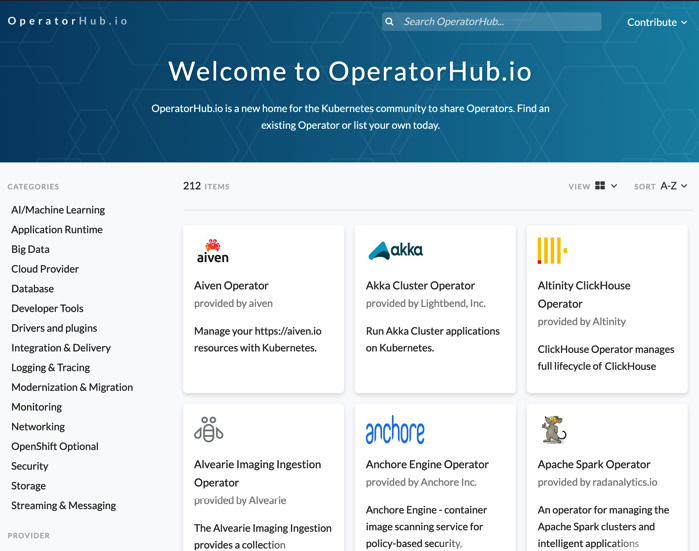Distributing Operators on OperatorHub.io
The final core component of the Operator Framework is OperatorHub.io. As a major open source project, the Operator Framework ecosystem is built on the open sharing and distribution of projects. Therefore, OperatorHub powers the growth of Operators as a Kubernetes concept.
OperatorHub is an open catalog of Operators published and managed by the Kubernetes community. It serves as a central index of freely available Operators, each contributed by developers and organizations. You can see an overview of the OperatorHub.io home page in the following screenshot:

Figure 1.2 – Screenshot of the OperatorHub.io home page, showing some of the most popular Operators
The process for submitting an Operator to OperatorHub for indexing has been standardized to ensure the consistency and compatibility of Operators with OLM. New Operators are reviewed by automated tooling for compliance with this standard definition of an Operator. The process is mainly handled through the open source GitHub repository that provides the backend of OperatorHub. However, OperatorHub does not provide any assistance with the ongoing maintenance of an Operator, which is why it is important for Operator developers to share links to their own open source repositories and contact information where users can report bugs and contribute themselves.
Preparing an Operator for submission to OperatorHub involves generating its bundle and associated manifests. The submission process primarily relies on the Operator's Cluster Service Version (CSV). The CSV is a YAML file that provides most of the metadata to OLM and OperatorHub about your Operator. It includes general information such as the Operator's name, version, and keywords. However, it also defines installation requirements (such as role-based access control (RBAC) permissions), CRDs, APIs, and additional cluster resource objects owned by the Operator.
The specific sections of an Operator's CSV include the following:
- The Operator's name and version number, as well as a description of the Operator and its display icon in Base64-encoded image format
- Annotations for the Operator
- Contact information for the maintainers of the Operator and the open source repository where its code is located
- How the Operator should be installed in the cluster
- Example configurations for the Operator's CRD
- Required CRDs and other resources and dependencies that the Operator needs to run
Because of all the information that it covers, the Operator CSV is usually very long and takes time to prepare properly. However, a well-defined CSV helps an Operator reach a much wider audience. Details of Operator CSVs will be covered in a later chapter.



